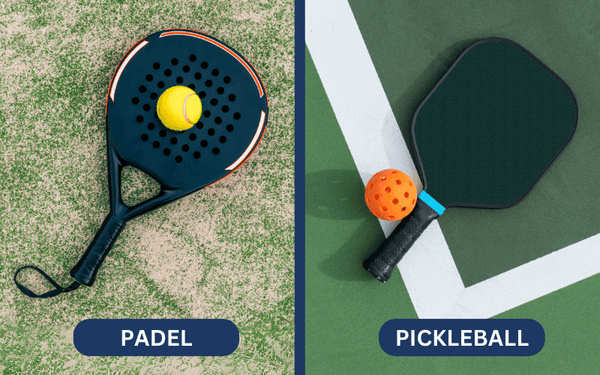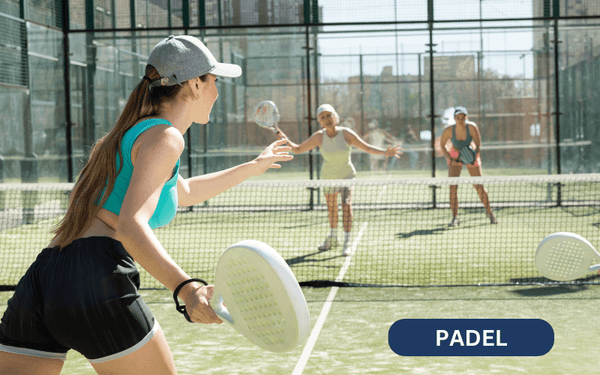No Products in the Cart
When considering padel vs pickleball, enthusiasts often find themselves comparing two of the most rapidly growing racquet sports in the world. While they share some similarities in their social appeal and ease of learning, these sports have unique characteristics that cater to different preferences and styles.
This time we decided to delve deeper into the nuances of padel and pickleball, highlighting what makes each sport distinct and appealing.

Padel and pickleball share captivating origin stories, born from a blend of boredom and creativity. Their inventors, seeking to add some excitement to traditional racquet sports, could never have imagined that they were creating what would become massive global attractions in the sports world.
History of Padel
Imagine a sunny day in Mexico, 1969. Enrique Corcuera, a businessman, looks at his squash court and thinks, "Let's spice this up!" He adds walls, tweaks the rules, and voila – padel is born! Soon, padel become a sensation - first in Spain and then globally. Its introduction to Spain's elite, particularly in the Marbella region, set the stage for its rapid expansion. Padel's appeal lies in its unique combination of tennis and squash elements, played in an enclosed court. Over the years, padel has grown exponentially, especially in European and Latin American countries, becoming a sport with professional leagues and an international fanbase.
History of Pickleball
Meanwhile, over in the USA in 1965, three friends are trying to cure their families' boredom. They grab some ping-pong paddles, a wiffle ball, and start hitting around on an old badminton court. That's how pickleball starts – a backyard invention on Bainbridge Island, near Seattle. The name? That’s even more interesting story - if you want to read it make sure to check our article “How does pickleball got its name?” This hybrid sport, combining elements of tennis, badminton, and table tennis, quickly became a favorite in the U.S., spreading through community centers and schools. Its growth has been marked by its simplicity and inclusive nature, leading to its burgeoning popularity not only in North America but also internationally, with many countries now hosting pickleball tournaments and clubs.

Padel's Specifics: The padel court, smaller and enclosed with walls, offers a unique playing experience. Players use a solid, stringless racquet, smaller than a tennis racquet, and a specialized ball, similar to a tennis ball but with less pressure. This setup creates a game that emphasizes strategic play and quick reflexes.
Pickleball's Specifics: Pickleball is played on a court akin to a badminton court, featuring a lower net and a distinct non-volley zone known as the 'kitchen.' The equipment includes solid paddles, which look like oversized ping-pong paddles, and a lightweight, perforated plastic ball. This combination results in a game that is accessible to players of all ages and skill levels, focusing on strategic placement and coordination.
Padel typically played in doubles, features a scoring system similar to tennis, but with an exciting twist: the walls are in play. This unique element adds a layer of strategy and agility, as players must skillfully use the walls for rebound shots, creating a dynamic and fast-paced game. The padel court, smaller than a tennis court and enclosed, requires quick movements and strategic thinking, making every match a thrilling experience.
Pickleball can be enjoyed in singles or doubles and has a unique scoring system where points are earned only by the serving side. One of pickleball's defining features is the 'kitchen' – a non-volley zone near the net. This rule prohibits players from executing volleys within this zone, thus emphasizing strategic placement over power. Pickleball's combination of accessible rules and the requirement for strategic play makes it a favorite among players of various ages and skill levels.
Padel is a dynamic sport that requires agility and quick reflexes. Playing in an enclosed space with walls means players must constantly adapt and react, enhancing their spatial awareness and coordination. It's a sport that not only keeps you physically active but also challenges your strategic thinking and teamwork skills.
Pickleball, while accessible and less physically intense, still demands a good level of fitness. The key lies in strategic shot placement and the ability to read the game. Mastering pickleball involves honing precise control over the ball and developing tactical awareness, especially with the 'kitchen' area rule. It's a sport that offers a balanced workout, combining physical activity with mental sharpness.
When we take a closer look at padel and pickleball in the USA, it's like comparing apples to oranges. Pickleball really stands out here, having become incredibly popular, especially with the older generations. The game has grown rapidly, now boasting over 4.8 million players across the nation. You’ll find them everywhere, from community centers in quiet suburbs to vibrant parks in big cities. Padel, on the other hand, is gradually making its presence known. While it’s not as widespread as pickleball, it has its own growing community, particularly in urban areas with cultural ties to Europe and Latin America. This sport tends to attract a younger crowd, many of whom are already familiar with similar racquet sports like tennis and squash.
Both sports contribute to the diverse and evolving landscape of recreational activities in the USA, each catering to different preferences and age groups. During the years, they have developed robust communities. Clubs and local courts often become hubs of social interaction, where friendships are forged, and the spirit of competition thrives.
The future of both padel and pickleball looks bright. With increasing international tournaments, celebrity endorsements, and a growing base of players, these sports are not just pastimes but are evolving into significant sporting movements.

So let’s conclude in a simple way. Padel is like playing tennis in a room – you’re on a smaller court surrounded by walls that are part of the game. It’s all about quick reflexes and using those walls to outsmart your opponent. Now, let’s switch to pickleball, which feels more like a mix of ping-pong and tennis. You play on a badminton-sized court, but there's a twist – a zone near the net called the 'kitchen' where you can’t volley, making the game more about strategy than power. Padel players wield solid, stringless racquets, perfect for rebound shots, while pickleballers use larger, solid paddles, ideal for precise, strategic shots. Padel is a fast-paced, strategic doubles game with a tennis-like scoring system. Pickleball, enjoyable as singles or doubles, has its own unique scoring, where patience and placement are key.
Padel and pickleball, each with its distinctive charm and gameplay, offer enriching experiences to sports enthusiasts. Whichever sport one chooses, the promise is of fun, fitness, and a vibrant community experience. Of course, to truly discover which sport aligns best with your personal style and physical capabilities, make sure to give both of them a try!
If you want to learn differences between pickleball and tennis or to reacmore pickleball related content, check out Born to Rally blog.